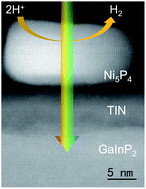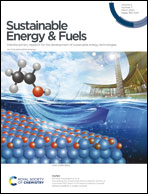Highly efficient and durable III–V semiconductor-catalyst photocathodes via a transparent protection layer†
Abstract
Durable performance and high efficiency in solar-driven water splitting are great challenges not yet co-achieved in photoelectrochemical (PEC) cells. Although photovoltaic cells made from III–V semiconductors can achieve high optical–electrical conversion efficiency, their functional integration with electrocatalysts and operational lifetime remain great challenges. Herein, an ultra-thin TiN layer was used as a diffusion barrier on a buried junction n+p-GaInP2 photocathode, to enable elevated temperatures for subsequent catalyst growth of Ni5P4 as nano-islands without damaging the GaInP2 junction. The resulting PEC half-cell showed negligible absorption loss, with saturated photocurrent density and H2 evolution equivalent to the benchmark photocathode decorated with PtRu catalysts. High corrosion-resistant Ni5P4/TiN layers showed undiminished photocathode operation over 120 h, exceeding previous benchmarks. Etching to remove electrodeposited copper, an introduced contaminant, restored full performance, demonstrating operational ruggedness. The TiN layer expands the synthesis conditions and protects against corrosion for stable operation of III–V PEC devices, while the Ni5P4 catalyst replaces costly and scarce noble metal catalysts.



 Please wait while we load your content...
Please wait while we load your content...